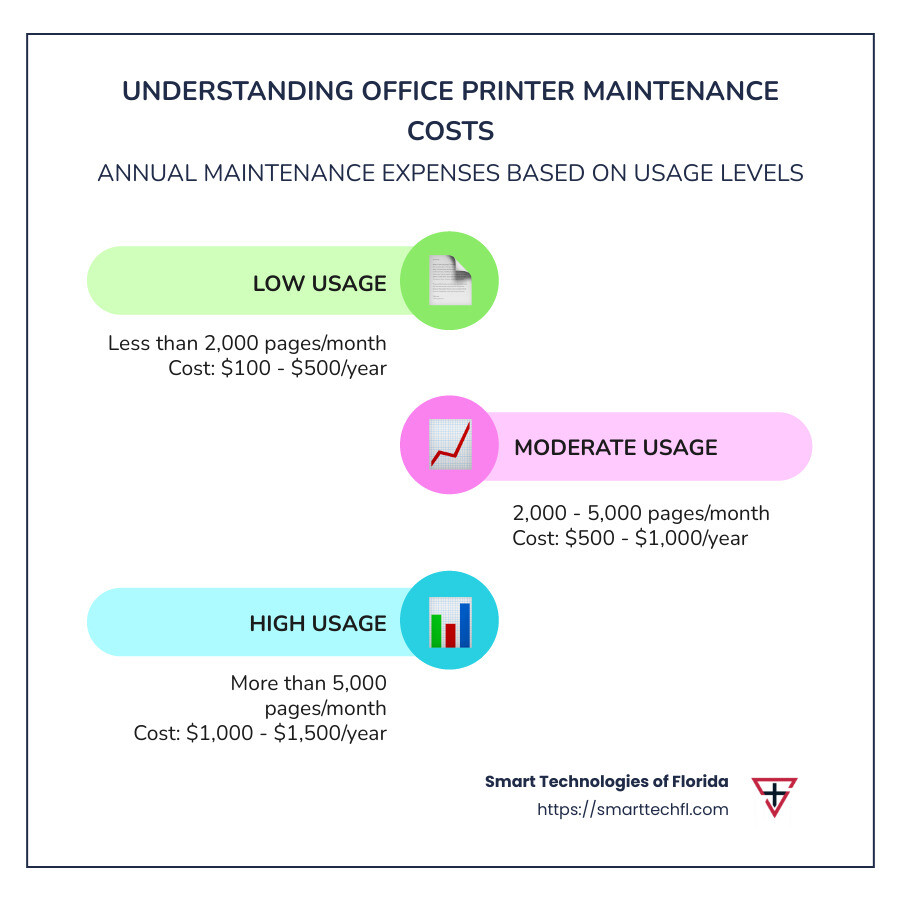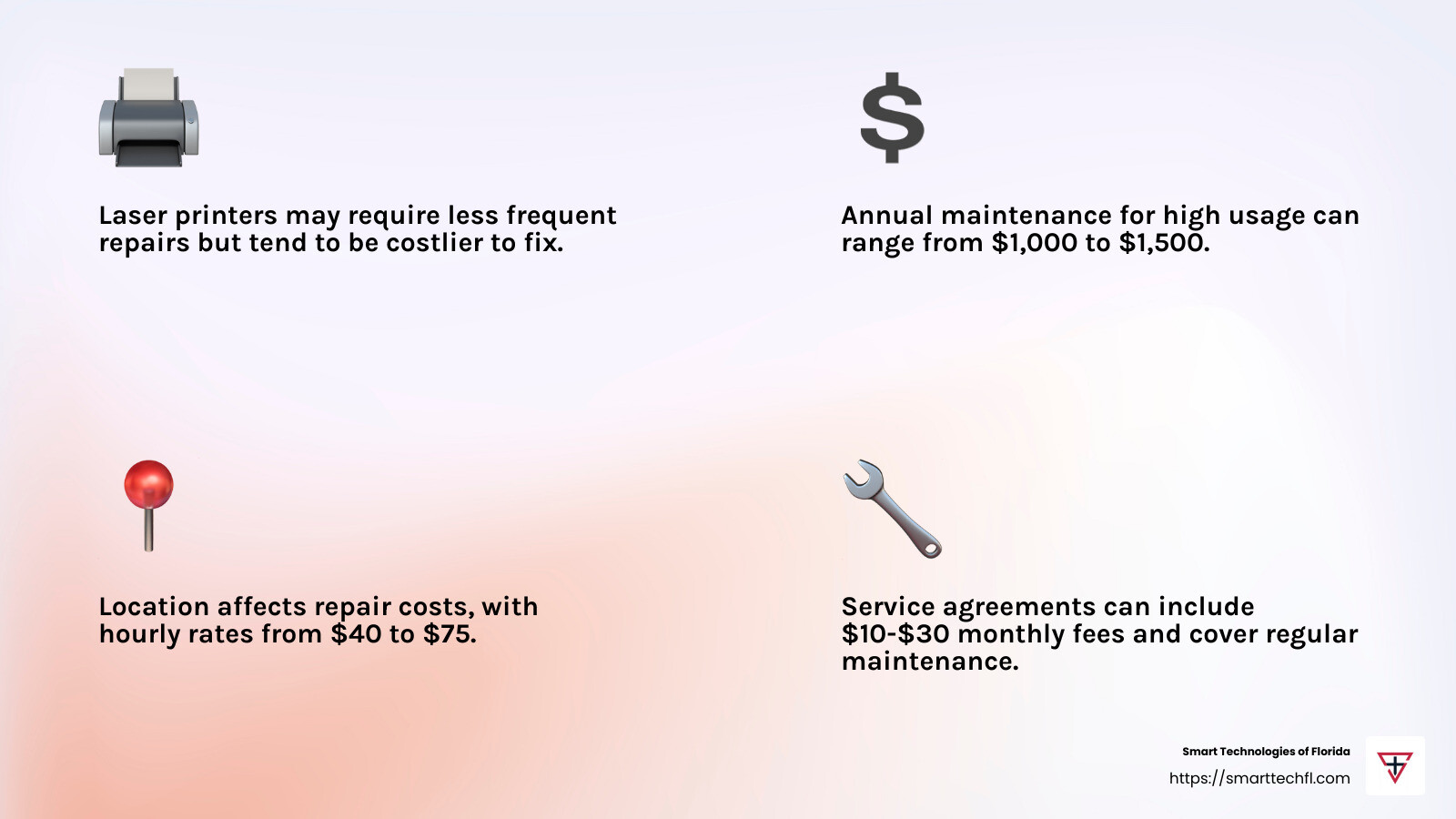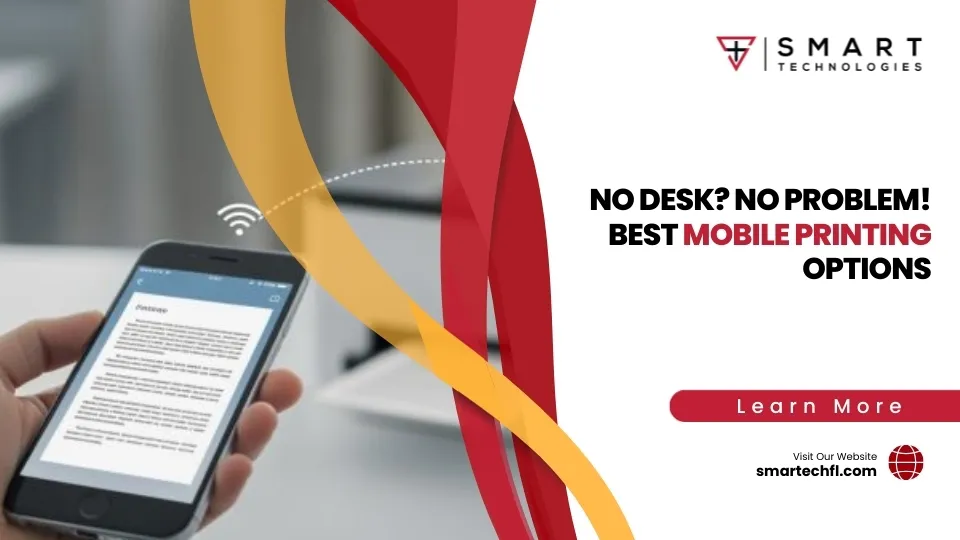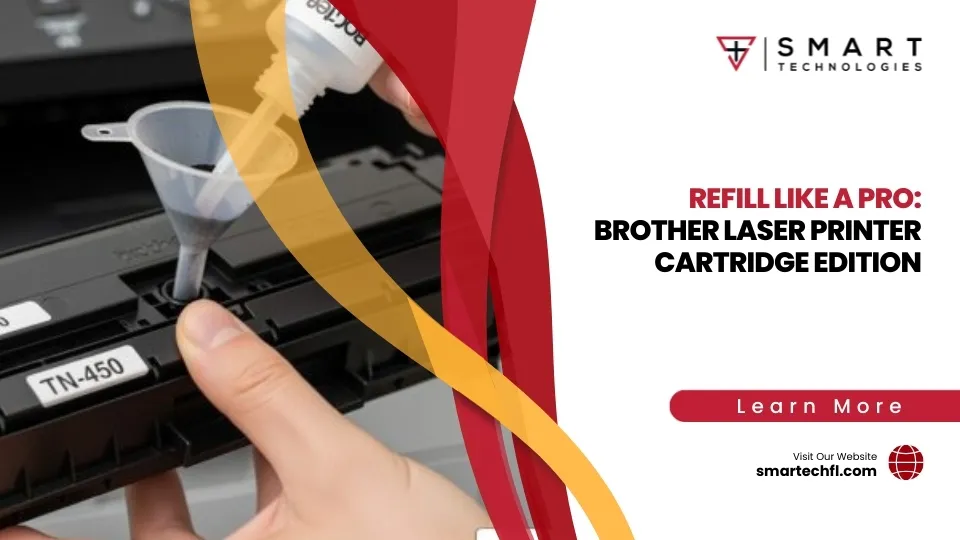The True Cost of Keeping Your Office Printer Running
The Hidden Costs of Office Printers
When thinking about how much is office printer maintenance costs per year, it’s crucial to consider more than just the upfront price tag. Imagine this: the annual maintenance costs for a typical office printer can range anywhere from $100 to $1,500, depending significantly on usage, location, and the type of service agreement you have in place.
- Low usage (less than 2,000 pages/month): $100 – $500 per year
- Moderate usage (2,000 – 5,000 pages/month): $500 – $1,000 per year
- High usage (more than 5,000 pages/month): $1,000 – $1,500 per year
The initial cost of purchasing a printer, whether it’s a sleek, modern model or a bargain-bin find, is only a part of its total cost of ownership (TCO). Over time, the expense of keeping it running efficiently, replacing parts, and regular maintenance start to add up, often more than you’d initially expect.
For example, with a quality brand like Kyocera, a higher upfront investment can lead to significant savings in the long run due to their durable components and less frequent need for maintenance.
A smart investment in the right printer with a clear understanding of its TCO can lead to reduced surprise expenses for your business over the years.

Understanding Office Printer Maintenance Costs
How Much is Office Printer Maintenance Per Year?
When assessing how much is office printer maintenance per year, break down the costs into a few key components: hourly labor rates, parts and labor, and repair costs.
Hourly Labor Rates
The cost of labor can vary widely depending on your location. For instance, in Chicago, standard printer repair services cost around $40 per hour. Meanwhile, in Arizona, you might see rates closer to $60 per hour, with a minimum charge of $35. In Texas, the first two hours of onsite service could cost $75, with each additional hour being $50. These rates underscore the importance of considering local pricing when estimating annual maintenance expenses.
Parts and Labor
Printer maintenance often involves replacing parts that wear out over time. A maintenance kit, which might include items like a transfer roll or feed roller, can cost around $261.99. A drum cartridge is another common replacement, priced at approximately $264.99. These costs can add up quickly, especially if your printer isn’t under a maintenance agreement.
Repair Costs
Repair costs depend on the complexity of the issue and the type of printer. On average, repairing a printer can range from $50 to $200, including parts and labor, with most problems resolved within 1-2 hours. However, if your printer is out of warranty and the repair costs exceed 50% of a new printer’s price, it might be more economical to replace it.
Average Annual Cost
The average annual maintenance cost for an office printer can vary significantly based on usage. For low usage (less than 2,000 pages per month), expect to spend between $100 and $500 annually. Moderate usage (2,000 – 5,000 pages per month) can cost $500 to $1,000, while high usage (over 5,000 pages per month) might push costs to $1,000 – $1,500 per year.
Service Frequency and Maintenance Agreements
Regular service is crucial for keeping printers in optimal condition. Maintenance agreements can offer peace of mind by covering regular check-ups and repairs. These agreements typically cost $10-$30 per month and can include per-page costs, such as $0.015 for black & white pages and $0.07-$0.15 for color. Having a maintenance plan can prevent unexpected repair costs and ensure that your printer remains functional without frequent disruptions.
In summary, understanding these aspects can help you better anticipate the annual costs associated with maintaining your office printer. With this knowledge, you can make more informed decisions about service agreements and the long-term value of your printer investment.
Factors Influencing Printer Maintenance Costs
When it comes to maintaining office printers, several factors can significantly affect the overall costs. Let’s dig into these aspects to help you better understand the financial implications of keeping your office printer running smoothly.
Cost of Printer Repairs
Printer Type and Usage Frequency
The type of printer you own plays a crucial role in determining repair costs. Laser printers typically have different maintenance needs compared to inkjet printers. For instance, laser printers might require less frequent repairs but can be more expensive when they do need fixing. On the other hand, inkjet printers might need more regular upkeep, especially if used heavily.
Usage frequency also impacts repair costs. A printer used for high-volume printing is likely to experience more wear and tear, leading to more frequent repairs. High usage (over 5,000 pages per month) can push annual maintenance costs to $1,000 – $1,500, as parts wear out faster.
Location-Based Pricing
Printer repair costs can vary based on location. For example, hourly labor rates in different areas can range from $40 to $75. It’s important to consider these local variations when budgeting for printer repairs.
Repair Time, Replacement Parts, and Labor Charges
The complexity of the repair affects both time and cost. Simple issues might be resolved in an hour, while more intricate repairs could take longer, increasing labor charges. Replacement parts like a maintenance kit ($261.99) or drum cartridge ($264.99) can also add to the cost. If repair expenses exceed 50% of the cost of a new printer, replacing the printer might be more economical.
Service Agreements vs. Pay-As-You-Go
Monthly Fees and Coverage Benefits
Opting for a service agreement can offer substantial benefits. These agreements typically include monthly fees ranging from $10 to $30 and cover regular maintenance, check-ups, and repairs. They often include per-page costs, such as $0.015 for black & white pages, which can be more cost-effective in the long run.
Cost-Effectiveness
A service agreement can save you from unexpected repair costs and reduce downtime. By covering both parts and labor, these agreements ensure your printer remains functional without frequent disruptions. This proactive approach can be especially beneficial for high-usage environments.
In conclusion, understanding these factors can help you make informed decisions about whether to choose a service agreement or a pay-as-you-go model for your office printer maintenance. This knowledge will enable you to plan better and manage costs effectively, ensuring your printer remains in top condition without breaking the bank.

Tips for Reducing Printer Maintenance Costs
When it comes to reducing printer maintenance costs, a few strategies can make a significant difference. Let’s explore some effective tips, including the benefits of Managed Print Services (MPS).
Managed Print Services
Preventive Maintenance
Preventive maintenance is key to keeping your printer in good shape and avoiding costly repairs. Regular checks can catch small issues before they become big problems. This includes cleaning printheads, checking toner levels, and ensuring software updates are applied. Preventive maintenance not only extends the life of your printer but also keeps your printing quality high.
Managed Print Services (MPS)
Opting for Managed Print Services can be a game-changer for businesses. MPS providers take care of everything from maintenance to supply management, freeing your team from the hassle of printer upkeep. This outsourcing allows you to focus on core business activities while experts handle your printing needs.
Cost Per Page
Understanding the cost per page is crucial for managing printing expenses. MPS often includes cost-per-page pricing, which offers predictability in your budget. This model allows you to pay a fixed price per page, eliminating unexpected costs and helping you plan better.
Outsourcing Benefits and Centralized Management
With MPS, you benefit from centralized management of all your printing devices. This means better oversight and streamlined operations. By consolidating your print services, you can reduce the number of devices needed, cutting down on energy use and supply costs. Companies like Procter & Gamble have reported up to 27% savings on printing costs by adopting such strategies.
Cost Savings
The cost savings from MPS can be substantial. By optimizing your print environment, you can save on both direct costs (like toner and paper) and indirect costs (like energy and maintenance). This approach not only reduces expenses but also improves efficiency and productivity across your organization.
By implementing these tips and considering Managed Print Services, you can significantly reduce your office printer maintenance costs and improve your overall printing strategy. Up next, we’ll dive into some frequently asked questions about printer maintenance to address common concerns and considerations.
Frequently Asked Questions about Printer Maintenance
How often should an office printer be serviced?
The frequency of servicing your office printer largely depends on how often you use it. For high-use environments, like busy offices, it’s wise to schedule maintenance every three to six months. This keeps your printer running smoothly and prevents small issues from turning into big, costly repairs.
For less frequent use, such as in a small office or home setting, servicing once a year might suffice. Regular maintenance includes cleaning, checking for worn parts, and updating software. Proper care can extend your printer’s lifespan and maintain print quality.
Is it worth repairing an old printer?
Deciding whether to repair or replace an old printer involves a cost-benefit analysis. If the repair costs exceed half the price of a new printer, it’s often more economical to buy a new one. This is especially true for printers that are out of warranty or nearing the end of their expected lifespan.
Consider the total cost of ownership (TCO) when making your decision. Newer models may offer better efficiency and lower cost per page, which can save you money in the long run. For example, the upfront cost difference in some models can be offset by significant savings in maintenance and consumables over time.
What is the cost per page for office printers?
The cost per page is a crucial metric for understanding your printer’s efficiency. It includes the cost of ink or toner and any maintenance expenses. To calculate it, divide the price of a toner or inkjet cartridge by the number of pages it can print.
Inkjet printers often have a higher cost per page compared to laser printers, but this can vary based on the printer model and usage. For businesses, adopting a managed print services model can help control these costs by offering a predictable cost-per-page pricing structure. This approach allows for better budget management and can prevent unexpected expenses.
By keeping these factors in mind, you can make informed decisions about your office printer maintenance and usage. Understanding service frequency, repair vs. replacement scenarios, and cost per page can lead to smarter, cost-effective printing strategies.
Conclusion
At Smart Technologies of Florida, we understand that managing your office printer costs is about more than just the initial price tag. It’s about strategic change and embracing custom solutions that align with your business goals.
With over 23 years of experience, we specialize in helping businesses like yours transform their office environments through custom digital solutions. Our people-centric approach ensures that we don’t just meet your needs—we anticipate them, providing solutions that empower your organization to thrive.
When it comes to office printers, we offer more than just machines. We provide expertise in understanding the total cost of ownership, ensuring that you make informed decisions that save money in the long run. From service agreements that cover all your maintenance needs to Managed Print Services that streamline your operations, we have the solutions you need to keep your office running smoothly.
If you’re ready to take control of your office printing costs and explore custom solutions that fit your unique needs, contact us today. Let Smart Technologies of Florida be your partner in strategic change and innovation. Together, we can create a more efficient, cost-effective office environment.












